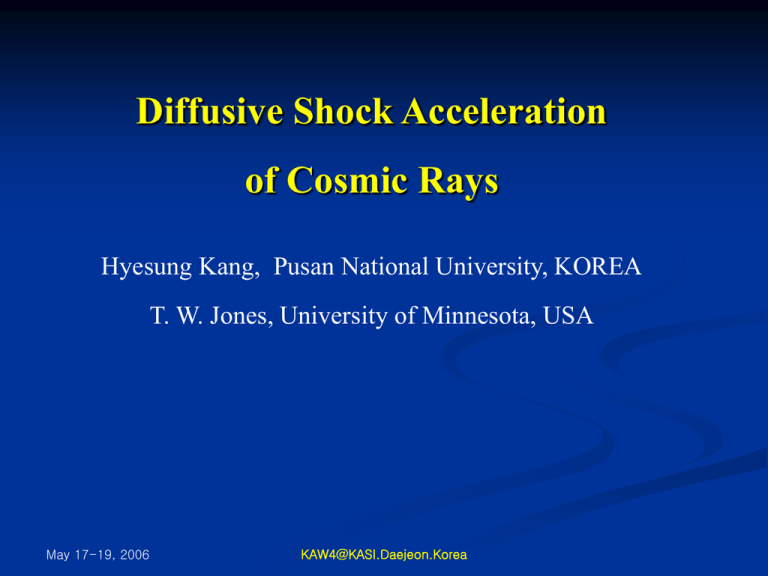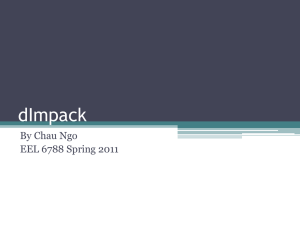Diffusive shock acceleration theory
advertisement

Diffusive Shock Acceleration of Cosmic Rays Hyesung Kang, Pusan National University, KOREA T. W. Jones, University of Minnesota, USA May 17-19, 2006 KAW4@KASI.Daejeon.Korea - Astrophysical plasmas are ionized, magnetized, often shock heated, tenuous gas. - CRs & turbulent B fields are ubiquitous in astrophysical plasmas. - It is important to understand the interactions btw charged particles and turbulent B fields to understand the CR acceleration. - Diffusive shock acceleration provides a natural explanation for CRs. -Recent Progresses in DSA theory: 1) injection and drift acceleration at perpendicular shocks 2) comparison with DSA theory with observation of SNRs 3) DSA simulation of 1D spherical SNRs May 17-19, 2006 KAW4@KASI.Daejeon.Korea Interactions between particles and fields downstream upstream scattering of particles in turbulent magnetic fields isotropization in local fluid frame transport can be treated as diffusion process || rg ( , i.e. mean scattering time crossing time ) Vsh streaming CRs - drive large-amplitude Alfven waves - amplify B field( Lucek & Bell 2000) May 17-19, 2006 KAW4@KASI.Daejeon.Korea Numerical Methods for the Particle Acceleration - Full plasma simulations: follow the individual particles and B fields, provide most complete picture, but computationally too expensive - Monte Carlo Simulations with a scattering model: reproduces observed particle spectrum (Ellison, Baring 90s) applicable only for a steady-state shock - Two-Fluid Simulations: solve for ECR + gasdynamics computationally cheap and efficient, but strong dependence on closure parameters ( , C ) and injection rate (Drury, Dorfi, KJ 90s) - Kinetic Simulations : solve for f(p) + gasdynamics Berezkho et al. code: 1D spherical geometry, piston driven shock , applied to SNRs, renormalization of space variables with diffusion length i.e. x( p) ( p) : momentum dependent grid spacing Kang & Jones code: 1D plane-parallel and spherical geometry, AMR technique, self-consistent thermal leakage injection model coarse-grained finite momentum volume method May 17-19, 2006 KAW4@KASI.Daejeon.Korea Complex microphysics: particles waves in B field Following individual particle trajectories and evolution of fields are impractical. diffusion approximation (isotropy in local fluid frame is required) Diffusion-convection equation for f(p) = isotropic part in Kinetic simulations f f 1 f f (U i uw,i ) (U uw ) p ( i , j ) Q( x, p) t xi 3 p xi x j Injection coefficient shock B u w Alfven wav e drift speed xx || cos 2 Bn sin 2 Bn : normal to shock n Bn Bn angle btw shock normal and mean field lines x Geometry of an oblique May 17-19, 2006 shock KAW4@KASI.Daejeon.Korea Parallel (Bn=0) vs. Perpendicular (Bn=90) shock xx Slide from Jokipii (2004): KAW3 cross- field diffusion xx || parallel diffusion Injection is efficient at parallel shocks, while it is difficult in perpendicular shocks May 17-19, 2006 KAW4@KASI.Daejeon.Korea Three Shock Acceleration mechanisms work together. 1) First-order Fermi mechanism: scattering across the shock dominant at quasi-parallel shocks (Bn< 45) 2) Shock Drift Acceleration: drift along the shock surface dominant at quasi-perpendicular shocks (Bn> 45) 3) Second-order Fermi mechanism: Stochastic process, turbulent acceleration add momentum diffusion term May 17-19, 2006 KAW4@KASI.Daejeon.Korea Diffusive Shock Acceleration in quasi-parallel shocks Alfven waves in a converging flow Shock front act as converging mirrors B particles are scattered by waves cross the shock many times “ Fermi first order process” p U s energy gain ~ at each crossing p v vc mean field U2 U1 upstream particle downstream shock rest frame Converging mirrors May 17-19, 2006 KAW4@KASI.Daejeon.Korea Parallel diffusion coefficient || hrg || m. f. p. 1 || hrg parallel 3 h 1 For completely random field (scattering within one gyroradius, h=1) “Bohm diffusion coefficient” 1 p || B rg minimum value 3 B particles diffuse on diffusion length scale ldiff = ||(p) / Us so they cross the shock on diffusion time tdiff = ldiff / Us= ||(p) / Us2 smallest means shortest crossing time and fastest acceleration. Bohm diffusion with large B and large Us leads to fast acceleration. highest Emax for given shock size and age for parallel shocks May 17-19, 2006 KAW4@KASI.Daejeon.Korea Thermal leakage injection at quasi-parallel shocks: due to small anisotropy in velocity distribution in local fluid frame, hot thermalized plasma unshocked gas suprathermal particles in nonMaxwellian tail leak upstream of shock Bw compressed waves CRs streaming upstream generate MHD waves (Bell & Lucek) compressed and amplified in downstream: Bw selfgenerated wave Bohm diffusion is valid B0 uniform field leaking particles Suprathermal particles leak out of thermal pool into CR population. May 17-19, 2006 KAW4@KASI.Daejeon.Korea Drift Acceleration in perpendicular shocks with weak turbulences y 1 || 1 (|| / rg ) || h B , 2 : classical scattering theory h B 1 h 2 h || / rg 1 for weak t urbulence || B 1 E V B c x so accelerati on is faster at perpend. shocks BUT, to ensure that diffusion approx. is valid, ,min ~ B ( Vs ) ~ B 0.01 c for 3000km/s Particle trajectory in weakly turbulent fields Energy gain comes mainly from drifting in the convection electric field along the 1 shock surface (Jokipii, 1982), i.e. e = |q E L|, E V B c “Drift acceleration” but particles are advected downstream with field lines, so injection is difficult: (Baring et al. 1994, Ellison et al. 1995, Giacalone & Ellison 2000) May 17-19, 2006 KAW4@KASI.Daejeon.Korea Diffusive Shock Acceleration at oblique shocks || xx || cos Bn sin Bn 2 2 diffusion normal to shock surface 1 : classical scattering theory || 1 (|| / rg ) 2 but / || ~ 0.02 0.04 : for turbul ent field due to field line meandering since t acc 4 p 2xx : accelerati on time scale dp / dt U s Giacalone & Jolipii 1999 the accelerati on is faster at a perpendicu lar shock Turbulent B field with Kolmogorov spectrum smaller xx at perpendicular shocks shorter acceleration time scale higher Emax than parallel shocks Monte Carlo Simulation by Meli & Biermann (2006) May 17-19, 2006 KAW4@KASI.Daejeon.Korea Test-Particle simulation at oblique shocks : Giacalone (2005a) (B/B)2=1 dJ/dE = f(p)p2 stronger turbulence more efficient injection Injection energy weakly depends on Bn for fully turbulent fields. ~ 10 % reduction at perpendicular shocks May 17-19, 2006 KAW4@KASI.Daejeon.Korea Test-Particle simulation at oblique shocks : Giacalone (2005a) (B/B)2=1 dJ/dE = f(p)p2 weak fluctuations The perpendicular shock accelerates particles to higher energies compared to the parallel shock at the same simulation time . May 17-19, 2006 Injection is less efficient, but acceleration is faster at perpendicular shocks for weakly turbulent fields. KAW4@KASI.Daejeon.Korea Hybrid plasma simulations of perpendicular shock : Giacalone (2005b) - acceleration of thermal protons by perpendicular shocks : thermal leakage - Field line meandering due to large scale turbulent B fields increased cross-field transport efficient injection at shock - thermal particles can be efficiently accelerated to high energies by a perpendicular shock -injection problem for perpendicular shocks: solved ! Particles are injected where field lines density of particles with energies E > 10Ep cross the shock surface dotted lines: field lines May 17-19, 2006 efficient injection KAW4@KASI.Daejeon.Korea Parallel vs. Perpendicular Shocks for Type Ia SNRs : ion injection Ion injection only for quasi-parallel shocks (polar cap regions only) spherical flux from paralleshock shock calculations should be reduced by fre ~0.2 May 17-19, 2006 KAW4@KASI.Daejeon.Korea Determination of B amplification factor, ion injection rate, proton-to-electron number ratio with SNR observations: Comparison with kinetic simulation (Berezhko & Voelk) x Slide from Voelk (2006) May 17-19, 2006 KAW4@KASI.Daejeon.Korea Recent Observations of SNRs in X-ray and radio: (Voelk et al. 2005) Cas A, SN 1006, Tyco, RCW86, Kepler, RXJ1737, … - thin shell of X-ray emission (strong synchrotron cooling) B field amplification through streaming of CR nuclear component into upstream plasma (Bell 2004) is required to fit the observations Observational proof for dominance of hadronic CRs at SNRs -Dipolar radiation: consistent with uniform B field configuration - Ion injection rate : x~10-4 - Proton/electron ratio: Kp/e ~ 50-100 -~50% of SN explosion energy is transferred to CRs. Consistent picture of DSA at SNRs May 17-19, 2006 KAW4@KASI.Daejeon.Korea CRs observed at Earth: N(E): power-law spectrum “universal” acceleration mechanism working on a wide range of scales DSA in the test particle limit predicts a universal power-law E-2.7 f(p) ~ p-q N(E) ~ E-q+2 q = 3r/(r-1) r = r2/r1=u1/u2 E-3.1 this explains the universal power-law, independent of shock parameters ! May 17-19, 2006 KAW4@KASI.Daejeon.Korea CR acceleration efficiency F vs. Ms for plane-parallel shocks Kang & Jones 2005 u0=(15km/s)M0 1) The CR acceleration efficiency is determined mainly by Ms 2) It increases with Ms (shock Mach no.) u0=(150km/s)M0 but it asymptotes to a limiting value of F ~ 0.5 for Ms > 30. Effects of upstream CRs -4 -3 3) thermal leakage process: a fraction of x= 10 - 10 of for low Ms shocks the incoming particles become CRs (at quasi-parallel shocks). F(t ) dxECR ( x, t ) 0.5r 0V t May 17-19, 2006 3 s , x (t ) 2 dx 4 p f CR ( p)dp KAW4@KASI.Daejeon.Korea ' n u o o dt Diffusion-Convection Equation with Alfven wave drift + heating f f 1 f 1 f (u u w ) 2 [r 2 (u u w )] p 2 [r 2 ( x, p ) ] Q( x, p ) t r 3r r p r r x where wave speed is u w A in upstream, u w 0 in downstream , A B / 4r is Alfven speed. Pc W -A : Gas heating term due to Alfven wav e disspation in upstream r - Streaming CRs generate waves upstream - Waves drift upstream with A - Waves dissipate energy and heat the gas. streaming CRs generate waves - CRs are scattered and isotropized in the wave frame rather than the gas frame u u u instead of u w 1 A smaller vel jump and less efficient acceleration upstream May 17-19, 2006 A U1 KAW4@KASI.Daejeon.Korea - CRASH code in 1D plane-parallel geometry = Adaptive Mesh Refinement (AMR) + shock tracking technique in the shock rest frame (thru Galilean velocity transformation) (Kang et al. 2001) - new CRASH code in 1D spherical geometry = Adaptive Mesh Refinement (AMR) + shock tracking technique in a comoving frame which expands with the shock The shock stays in the same location (zone). just like Hubble expansion Rs = xs a Rs May 17-19, 2006 KAW4@KASI.Daejeon.Korea Basic Equations for 1D spherical shocks in the Comoving Frame 2 r~ 1 (r~ ) r~ ax t a x ~ ~ ~ 2 P ~ r ( a 2 ( r ) 1 g Pc ) r~ 2 r~ axr~ a ax x a t ~ ~ ~ ( r~e~g ) 1 ( r~e~g Pg Pc ) a ~~ Pc 2 ~~ ~ ( r eg Pg ) 2 r eg axr~ a a x ax x a t ~ ~ a ~ g 1 ~ ~ 2 ~ S 1 (S ) r 2 S ~ g 1 [W L ] a ax t a x r 1 2 g~ a ~ a g~ 1 2 g~ ( u w ) g~ ~ (x ) [ x ( u w )] ]( 4 g ) 3 g 2 2 [ x a x x a a y 3ax x x a t ~ ~ g 1 ~ ~ ~ 4~ 3 ~ 3 3 ~ r ra , P P a , P P a , S P / r , g p f , y ln( p) g g c c g ~ L La 3 , L energy loss due to CR injection ~ W Wa 3 , W heating due to wave dissipatio n May 17-19, 2006 KAW4@KASI.Daejeon.Korea Wave drift + heating terms SNR simulations with 1D spherical CRASH code - Supernova parameters : Eo 1051 erg (explosion energy), M SN 10M sun - Bohm - type Diffusion 3.0 10 22 p 2 (p) ( cm /s) with B 5G B mc - Preexistin g CR population : f ( p) f o p 4.5 , Pc / Pg 0.05 and 0.5 far upstream - thermal leakage injection model - initial conditions : Sedov - Taylor solution at ~ t 1 - warm uniform ISM condition : nH 0.3 cm 3 , To 10 4 K initial shock Mach number : M s 130 - Normalizat ion constants ro 6.14pc, to 1.3 103 yr, uo 4.6 103 km/s r o 7.0 10 25 g/cm 3 , Po 1.5 10 7 erg/cm 3 , o 8.6 10 27 cm 2 /s May 17-19, 2006 KAW4@KASI.Daejeon.Korea warm uniform ISM : nH 0.3 cm 3 , To 104 K, M s 130 at t 1 Normalizat ion Constants ro 6.14pc, to 1.3 103 yr, uo 4.6 103 km/s r o 7.0 10 25 g/cm 3 , Po 1.5 10 7 erg/cm 3 , o 8.6 10 27 cm 2 /s e injection parameter x0 6.0 10 4 x8 2.3 10 6 at the 8th level Pc , 0 0.5Pg , 0 Strong nonlinear modification. May 17-19, 2006 KAW4@KASI.Daejeon.Korea warm uniform ISM : nH 0.3 cm 3 , To 104 K, M s 130 at t 1 Normalizat ion Constants ro 6.14pc, to 1.3 103 yr, uo 4.6 103 km/s r o 7.0 10 25 g/cm 3 , Po 1.5 10 7 erg/cm 3 , o 8.6 10 27 cm 2 /s e injection parameter x0 6.0 10 4 x8 2.3 10 6 at the 8th level Pc , 0 0.5Pg , 0 moderate nonlinear modification May 17-19, 2006 KAW4@KASI.Daejeon.Korea r1 / r 0 2 r2 / r0 8 M s 130 5 Pc , 2 /( r oU st2 ) 0.4 Pg , 2 /( r oU st2 ) 0.2 x 10-3 10 4 x (t ) 2 dx 4 p f ( p ) dp ' n u o o dt = total CR number / particle no. passed though shock May 17-19, 2006 KAW4@KASI.Daejeon.Korea N p f (r , p) p 2 r 2 dr , Gp N p p2 q d (ln N p ) d ln p N p : power-law like G p : non-linear concave curvature q ~ 2.2 near pinj q ~ 1.6 near pmax Our results are consistent with the calculations by Berezhko et al. May 17-19, 2006 KAW4@KASI.Daejeon.Korea Summary - CRs & turbulent B fields are natural byproducts of the collisionless shock formation process: they are ubiquitous in cosmic plasmas . - DSA produces a nearly universal power-law spectrum with the correct slopes. - With turbulent fields, thermal leakage injection works well even at perpendicular shocks as well as parallel shocks - / || 1 , so perpendicular shocks are faster accelerators - About 50 % of shock kinetic E can be transferred to CRs for strong shocks with Ms > 30. - thermal leakage process: a fraction of x = 10-4 - 10-3 of the incoming particles become CRs at shocks. - Observations of SNRs support the dominance of CR ions (through amplified B field) and x = 10-4 - 10-3 and Kp/e ~ 100. May 17-19, 2006 KAW4@KASI.Daejeon.Korea Test-Particle simulations at oblique shocks : Giacalone (2005a) o 3U1 : initial speed B B B : random fluctuatio ns with P(k) are imposed. particle trajector ies are followed. Model Parameters ; B , Bn B 2 May 17-19, 2006 KAW4@KASI.Daejeon.Korea Numerical Tool:CRASH (Cosmic Ray Amr SHock ) Code 2 p Bohm type diffusion: ( p) p for p >>1 p2 1 - wide range of diffusion length scales to be resolved: from thermal injection scale to outer scales for the highest p 1) Shock Tracking Method (Le Veque & Shyue 1995) - tracks the subshock as an exact discontinuity 2) Adaptive Mesh Refinement (Berger & Le Veque 1997) - refines region around the subshock with multi-level grids Nrf=100 May 17-19, 2006 KAW4@KASI.Daejeon.Korea Kang et al. 2001 t=0 “CR modified shocks” - presusor + subshock - reduced Pg - enhanced compression -1D Plane parallel Shock DSA simulation postshock preshock Time evolution of the M0 = 5 shock structure. At t=0, pure gasdynamic shock with Pc=0 (red lines). No simple shock jump condition Need numerical simulations to calculate the CR acceleration efficiency precursor Kang, Jones & Gieseler 2002 May 17-19, 2006 KAW4@KASI.Daejeon.Korea Evolution of CR distribution function in DSA simulation f(p): number of particles in the momentum bin [p, p+dp], g(p) = p4 f(p) CR feedback effects gas cooling (Pg decrease) initial Maxwellian thermal leakage thermal power-law tail concave curve at high E power-law tail (CRs) f(p) ~ p-q g(p) = f(p)p4 3u1 q( p) u1 u2 Particles diffuse on different ld(p) and feel different u, so the slope depends on p. Concave curve May 17-19, 2006 KAW4@KASI.Daejeon.Korea electron acceleration mechanisms: direct electric field acceleration (DC acceleration) (Holman, 1985; Benz, 1987; Litvinenko, 2000; Zaitsev et al., 2000) stochastic acceleration via wave-particle interaction (Melrose, 1994; Miller et al., 1997) shock waves (Holman & Pesses,1983; Schlickeiser, 1984; Mann & Claßen, 1995; Mann et al., 2001) outflow from the reconnection site (termination shock) (Forbes, 1986; Tsuneta & Naito, 1998; Aurass, Vrsnak & Mann, 2002) May 17-19, 2006 KAW4@KASI.Daejeon.Korea Thermal Leakage Injection at parallel shocks has been observed - suprathermal particle leak out of thermal pool into CR population (power-law tail) injection rate x ~ 10-4 – 10-3 postshock preshock CRs May 17-19, 2006 KAW4@KASI.Daejeon.Korea comparison of Monte Carlo simulations with direct measurement at Earth’s bow shock




![Electrical Safety[]](http://s2.studylib.net/store/data/005402709_1-78da758a33a77d446a45dc5dd76faacd-300x300.png)




